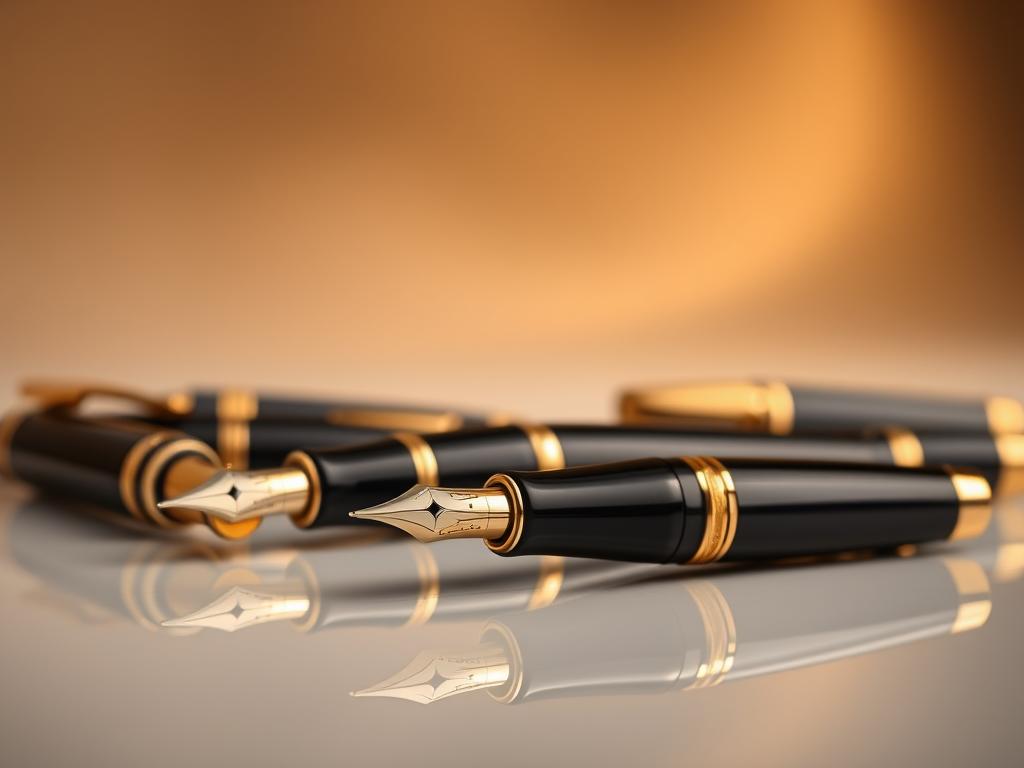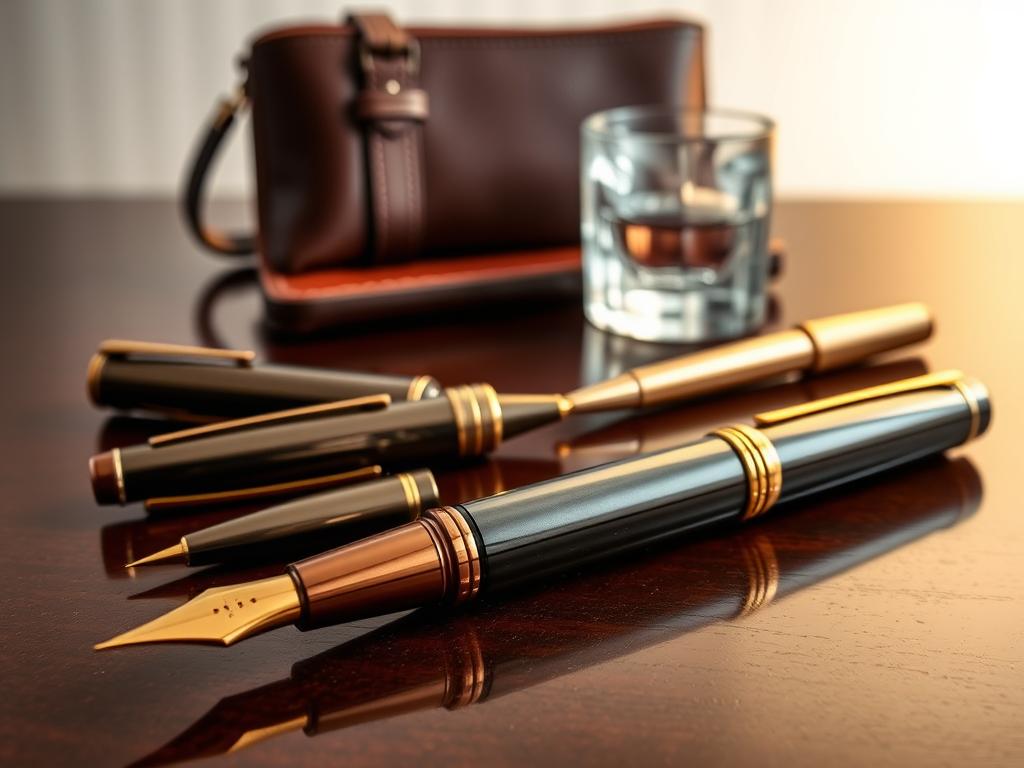Everyday writing can feel ordinary, but premium instruments transform it into something extraordinary. Unlike basic options, luxury pens blend artistry with engineering, turning simple tasks into moments of elegance. These tools aren’t just about jotting notes—they’re designed to create lasting impressions.
Craftsmanship plays a pivotal role. Brands like Montblanc and Parker use materials such as precious metals, rare resins, and even exotic leathers. Each piece is meticulously shaped by skilled artisans, ensuring flawless finishes and balanced weight. This attention to detail elevates functionality into a tactile pleasure.
Superior performance also sets these instruments apart. Precision-engineered nibs and consistent ink flow reduce hand fatigue while enhancing control. For example, fountain pens from Montegrappa often feature 18-karat gold nibs polished by hand—a hallmark of exceptional craftsmanship.
Beyond aesthetics, longevity matters. High-end designs endure decades of use, becoming heirlooms rather than disposable items. The term “luxury” here isn’t just about cost—it’s a promise of enduring quality and thoughtful design.
Key Takeaways
- Premium materials like gold, rare resins, and leather define luxury pens.
- Handcrafted details ensure flawless construction and ergonomic comfort.
- Precision nibs and smooth ink flow enhance the writing experience.
- Renowned brands prioritize durability, often creating lifelong investments.
- Subtle design elements reflect historical or cultural significance.
Introduction: A Journey from Everyday to Exquisite Writing
Imagine the smooth glide of ink on paper, turning routine notes into moments of sophistication. While standard pens get the job done, they rarely spark joy beyond convenience. Luxury fountain pens, however, elevate even grocery lists into elegant gestures. The difference lies in thoughtful design and engineering that adapts to your hand, not the other way around.
Exploring the World of Pen Comparisons
Choosing between everyday tools and refined instruments starts with understanding contrasts. Weight distribution, for instance, affects comfort during long sessions. Budget pens often feel light and flimsy, while luxury options balance heft for reduced strain. Ink flow matters too—cheaper models may skip or blot, but precision nibs in high-end designs deliver consistent lines.
| Feature | Everyday Pens | Luxury Fountain Pens |
|---|---|---|
| Materials | Plastic, basic metals | Gold, lacquer, rare resins |
| Nib Precision | Standard steel tips | Hand-polished 18K gold |
| Ink Flow | Inconsistent | Silky-smooth delivery |
Understanding the Impact on Your Writing Experience
Small details redefine daily habits. A well-crafted barrel fits naturally in the grip, while advanced filling systems—like piston mechanisms—make ink changes effortless. These elements transform writing from a chore to a ritual. Even the sound of a cap twisting into place carries satisfaction.
Exploring these differences isn’t about price tags. It’s about finding tools that mirror your personality and needs. Whether sketching ideas or signing documents, the right instrument amplifies creativity and confidence.
Understanding Craftsmanship and Materials in Luxury Pens
The soul of a writing instrument lies in its materials and the hands that shape them. While ordinary pens prioritize function, luxury counterparts blend artistry with science, creating tools that feel alive. This harmony starts with premium components and finishes with meticulous human touch.
Premium Materials and Unique Designs
High-end brands like Visconti and Pelikan source rare celluloid, a material prized for its depth and iridescence. Precious metals such as sterling silver or platinum accents add weight and sophistication. These elements aren’t just decorative—they ensure durability while reflecting light in mesmerizing ways.
Exotic resins, often layered by hand, create marbled effects impossible to replicate mechanically. For example, craftsmanship in luxury pens frequently involves curing resins for weeks to achieve flawless surfaces. Such patience transforms each piece into wearable art.
Handcrafted Excellence and Longevity
Artisans spend hours polishing nibs and aligning feeds, ensuring seamless ink flow. Unlike factory-made models, these pens adapt to the writer’s grip over time. A Montblanc Meisterstück, for instance, undergoes 100+ steps—each refining its balance and responsiveness.
This dedication extends a pen’s life. Gold nibs resist corrosion, while robust barrels withstand decades of use. Owners often pass them down, celebrating stories etched into every scratch. Here, craftsmanship isn’t a buzzword—it’s a legacy.
What Makes a Pen Luxury?
Behind every refined script is a tool engineered to merge precision with artistry. While standard markers focus on basic utility, elite instruments integrate technical mastery into every curve and mechanism. This dedication transforms writing from a task into a tactile dialogue between creator and tool.
Iconic Features That Define Luxury
Distinctive elements separate ordinary tools from heirloom-quality instruments. Nibs crafted from 18-karat gold, for example, adapt to the writer’s pressure, creating lines that widen or narrow with natural motion. Advanced ink reservoirs, like piston-fill systems, eliminate air bubbles for uninterrupted flow.
Barrels wrapped in Japanese urushi lacquer or Italian celluloid showcase textures that shimmer under light. These materials aren’t just visually striking—they resist wear while aging gracefully. Even the threads securing caps are polished to ensure silent, frictionless closure.
| Feature | Standard Pens | High-End Designs |
|---|---|---|
| Nib Material | Stainless steel | 18K gold, rhodium-plated |
| Ink System | Cartridge-based | Piston/vacuum mechanisms |
| Weight Balance | Top-heavy or uneven | Centered for reduced fatigue |
Superior Ink Flow and Nib Precision
Consistency defines premium performance. Each nib undergoes hours of hand-polishing to eliminate rough edges that cause skipping. Channels within the feed regulate ink delivery, matching the writer’s speed without blotting.
Brands like Sailor employ micro-grooves on tipping material to control saturation. This attention ensures crisp lines whether drafting quick notes or elaborate calligraphy. The result? A glide so smooth, it feels like the page collaborates with your thoughts.
Comparing Design, Functionality, and Writing Experience
The way a pen interacts with your hand shapes every word you write. While ordinary models prioritize simplicity, refined instruments focus on harmony between form and utility. This balance defines how effortlessly ideas flow onto paper.

Ergonomic Designs for Enhanced Comfort
High-end options like Montblanc’s Meisterstück feature tapered barrels that cradle fingers naturally. Weight distribution centers near the grip, reducing strain during long sessions. In contrast, disposable plastic pens often feel top-heavy, causing cramped fingers after minutes of use.
Textured resin or rubberized sections add grip without roughness. For example, Lamy’s Safari line uses molded grooves to guide hand placement. These thoughtful details transform extended writing from a chore to a pleasure.
Advanced Filling Mechanisms and Ink Delivery
Luxury fountain pens employ piston or vacuum systems that draw ink directly into reservoirs. This eliminates air bubbles, ensuring steady flow without blotting. Standard cartridge-based models rely on gravity, leading to inconsistent saturation.
Makoba’s studies highlight how ergonomic balance improves control. Paired with precision feeds, these mechanisms let ink glide evenly—whether sketching delicate lines or signing documents. The result? Fewer interruptions and more confidence in every stroke.
While premium tools cost more upfront, their reliability justifies the price. Brands like Noble Quills blend artistry with engineering, creating heirlooms that age gracefully. After all, true value lies in how effortlessly a pen becomes an extension of your thoughts.
The Role of Limited Editions and Customization
Owning a rare masterpiece transforms writing into a statement of individuality. High-end brands release numbered series—like Montblanc’s Patron of Art collection—where each piece tells a story through unique motifs. These limited editions aren’t just tools; they’re wearable history, appealing to collectors seeking exclusivity.
Exclusivity and Personalized Engraving
Personalization elevates instruments into cherished keepsakes. Engraving initials or dates adds emotional weight, turning everyday pens writing into heirlooms. Brands like Graf von Faber-Castell offer laser-etched signatures, while others provide bespoke nibs tailored to writing angles.
Custom options extend beyond monograms. Buyers can select barrel materials, clip designs, or ink colors to mirror their style. For milestones like graduations, these touches transform pens into timeless mementos. The result? A tool that feels uniquely yours—whether kept or gifted.
Collectors shop for rarity as much as function. Limited runs often appreciate over time, blending artistry with investment potential. A Visconti Divine Comedy edition, for instance, gains value while celebrating literary legacy. This duality makes high-end designs ideal for both personal indulgence and prestigious gift-giving.
Ultimately, customization bridges utility and legacy. Every engraved line or rare material choice reflects personality—and ensures these instruments outlast trends. After all, true luxury lies in creating something no one else can replicate.
Exploring Luxury Pen Brands and Their Legacy
Global acclaim in the pen industry isn’t earned overnight—it’s crafted through decades of excellence. Names like Montblanc, Montegrappa, and Parker have shaped writing culture since the early 20th century. Their reputations rest on relentless innovation and timeless design, making them staples for collectors and professionals alike.

Global Reputation and Iconic Style
Montblanc’s Meisterstück, launched in 1924, redefined elegance with its black resin body and platinum accents. Montegrappa, founded in 1912, merges Italian artistry with iconic style, using materials like sterling silver for limited-edition pieces. Parker’s Duofold, introduced in 1921, became a symbol of success with its vibrant lacquer and reliable performance.
These brands prioritize heritage. For example, Montegrappa’s Chaos model reflects mythological themes through intricate engravings. Montblanc collaborates with cultural institutions to celebrate historical figures, blending storytelling with craftsmanship. Such efforts cement their status as world luxury pens leaders.
Collectors gravitate toward designs that transcend trends. Parker’s arrow-shaped clips and Montblanc’s snowcap emblem are instantly recognizable. These elements aren’t just decorative—they represent decades of refinement. As one enthusiast noted, “Owning one feels like holding a piece of history.”
Longevity drives value. Limited editions from these houses often appreciate, combining artistry with investment potential. Whether used daily or displayed, their global reputation ensures they remain cherished across generations.
Benefits of Investing in Luxury Writing Instruments
A well-crafted writing instrument does more than mark paper—it becomes a lifelong companion. These tools merge practicality with prestige, offering rewards that unfold over decades. Whether for personal use or as a gift, their value extends far beyond the initial purchase.
Long-Term Durability and Value Retention
High-end instruments like Montblanc or Visconti models resist wear through robust materials. Gold nibs, hardened resins, and titanium accents ensure they outlast disposable alternatives. Many appreciate in value, especially limited editions, becoming sought-after collectibles.
Custom engraving adds sentimental worth. A Pelikan Souverän passed through generations carries stories alongside ink. “It’s not just a pen—it’s a family legacy,” notes one collector. This blend of emotional and financial returns makes them unique investments.
| Aspect | Standard Pens | Luxury Options |
|---|---|---|
| Materials | Plastic, basic alloys | Gold, palladium, rare woods |
| Resale Value | Depreciates quickly | Increases for rare models |
| Maintenance | Disposable | Serviceable for decades |
| Customization | Limited | Engraving, bespoke nibs |
Elevating the Daily Writing Experience
Professional writers often praise the seamless flow of premium fountain pens. Balanced weight and ergonomic design reduce hand fatigue during long sessions. The tactile pleasure of a smooth nib gliding across paper turns routine tasks into moments of focus.
Brands like Graf von Faber-Castell prioritize quality control, ensuring every stroke feels intentional. This reliability builds trust—a luxury pen won’t skip during critical signatures or creative bursts. Over time, these subtle improvements compound, making everyday writing feel effortless.
For those ready to shop, the choice isn’t just about aesthetics. It’s about selecting a tool that enhances productivity while holding its appeal. As one novelist shared, “My fountain pen doesn’t just write stories—it inspires them.”
Conclusion
A single stroke from a finely crafted instrument carries more than ink—it holds heritage. While plastic pens serve temporary needs, luxury fountain pens blend engineering with artistry. Gold nibs, weighted barrels, and hand-polished resins elevate writing from mundane to memorable.
Unlike disposable options, these tools become lasting companions. Brands like Graf von Faber-Castell use rare metals and precision feeds to ensure decades of flawless performance. Limited editions or engraved designs add personal significance, turning functional items into heirlooms.
The difference lies in details: ergonomic balance reduces fatigue, while piston-fill systems deliver ink like silk. Each piece reflects generations of refinement, merging cultural legacy with modern innovation. For those seeking to transform daily tasks, world luxury pens offer more than utility—they embody stories waiting to be written.
When choosing your next instrument, consider how craftsmanship and legacy align with your rhythm. After all, the right pen doesn’t just write—it lets every word become a brushstroke in your story.
FAQ
How do luxury fountain pens differ from regular ones?
High-end models like Montblanc or Graf von Faber-Castell use premium materials such as gold nibs, hand-polished resins, and precious metals. They prioritize smooth ink flow, ergonomic comfort, and meticulous craftsmanship, ensuring a refined writing experience.
Why are limited editions considered valuable?
Limited runs from brands like Pelikan or Visconti offer exclusivity, often featuring rare materials or artistic designs. Their scarcity enhances collectibility, making them both functional tools and appreciating assets.
Do luxury pens retain their value over time?
Yes. Iconic brands such as Parker Duofold or Waterman maintain strong resale markets due to timeless designs and durable construction. Well-maintained pieces often appreciate, especially limited editions or discontinued models.
What role does nib precision play in writing quality?
Gold or rhodium-plated nibs, like those on Sailor Pro Gear pens, adapt to handwriting styles over time. Their flexibility ensures consistent ink delivery, reducing hand fatigue and improving line consistency compared to rigid steel nibs.
Can luxury writing instruments be customized?
Many brands offer engraving services or interchangeable nibs. Aurora, for example, provides bespoke nib grinds, while Montegrappa allows personalized engravings, transforming pens into unique heirlooms.
Are high-end pens practical for daily use?
Absolutely. Models like Lamy 2000 or Pilot Custom Heritage combine durability with ergonomic designs. Their advanced filling systems, such as piston mechanisms, ensure reliability, making them ideal for both casual and professional settings.
How do materials impact a pen’s longevity?
Precious metals, celluloid, or aerospace-grade resins resist wear better than plastic. For instance, Caran d’Ache’s lacquered finishes or Yard-O-Led’s sterling silver bodies withstand decades of use while retaining aesthetic appeal.
What makes brands like Montblanc culturally significant?
Heritage plays a key role. Montblanc’s Meisterstück line, launched in 1924, symbolizes timeless elegance. Such brands blend historical artistry with modern innovation, creating pieces celebrated by collectors and writers alike.


